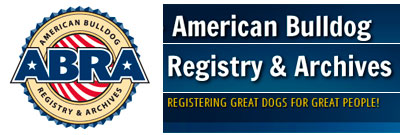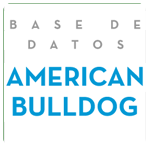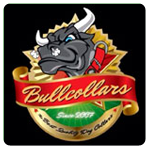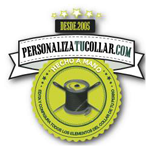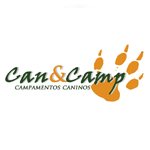The American Bulldog is an athletic, temperamentally sound medium to large sized dog that possesses great strength, agility and confidence. The expression should reflect intelligence and alertness. The sturdy and powerful yet compact frame is characteristically stockier and heavier boned in the males and more refined in the females. Some aloofness with strangers and assertiveness towards other dogs is accepted. However, an American Bulldog should not be excessively timid, shy or aggressive towards man and preferably not overly aggressive with other dogs. Due to its distinctive physical and mental characteristics along with its natural desire to be the total companion and working dog, an American Bulldog should never be confused with uniquely different breeds such as the American Staffordshire Terrier or the American Pit Bull Terrier.
Size-General: Males should range from 24 to 27 inches at the withers and weigh between 90 and 110 pounds. Females should range from 22 to 25 inches at the withers and weigh between 70 and 90 pounds. Weight should be proportional to height and body type. A dog should be well conditioned and not overweight or underweight.
Standard: A leaner and more athletic dog in appearance.
Classic: A larger and more powerful dog in appearance.
Color: Solid or varying degrees of white, all shades of brindle, brown, red, or tan are acceptable. Solid black, black and tan, and/or any degree of merle is unacceptable. A full black mask is not acceptable. **Merle is a dilution of overall body color (black or red) with splotches of darker color giving the effect of “merling” or “marbling” not to be confused with Brindle that gives the effect of “striping”.
Coat: Short, less than one inch in length varying from soft to stiff. Long, feathering, or fuzzy coats are unacceptable.
Head: The head should be relatively large and broad in proportion to the size and overall structure of the dog. It should be flat on top giving a squared appearance. There is a defined furrow between the eyes with a distinct, deep stop. The head is well-muscled throughout with prominent cheeks. An excessively narrow head is unacceptable in both types.
Standard: Generally box shaped to wedge in appearance with a slightly shallower stop and less wrinkles.
Classic: Generally box shaped to round in appearance with a more definitive stop and heavier wrinkles.
Eyes: The eyes should be round or almond shape, medium sized, and wide set. Black or dark brown is the preferred color. Other colors are accepted. Black eye rim pigment preferred. Crossed and/or nonsymmetrical eyes are unacceptable.
Muzzle: The muzzle should be relatively broad and square. The large jaws are well-muscled, displaying great strength. Lips are full but not pendulous. Black pigment lining lips preferred. An excessively narrow muzzle is unacceptable in both types.
Standard: muzzle should be 30% to 40% of the overall length of head.
Classic: muzzle should be 25% to 35% of the overall length of head.
Teeth: The teeth should number 42 to 44 and large in size is preferred. Working dogs should not be penalized for broken teeth. Should medical removal of teeth be needed, documentation and verification by a veterinarian is requested
Bite:
Standard: Reverse scissors is preferred. Moderate underbite, scissors or even bite is acceptable.
Classic: Undershot 1/4 to ½ inch preferred. Even bite is not preferred. Scissors bite is unacceptable.
Both types: Teeth should not be visible when the mouth is closed.
Nose: Black is the preferred color. A red, brown, or grizzle nose is acceptable. A pink or dudley nose is unacceptable.
Ears: The ears should be medium in size and may be either forward flap or rose, with no preference. Cropped ears is unacceptable.
Neck: The neck should be very muscular and medium in length. The neck should taper from shoulder to head and be slightly arched.
Shoulders: The shoulders should be well-muscled with good definition and wide sloping blades giving the appearance of great strength.
Chest: The chest should be deep and moderately wide giving the appearance of power and athletic ability. The front, overall, should be straight and well balanced. The chest should not be narrow or excessively wide nor should the elbows be angled out or pulled in.
Body: The body should be compact and moderately short while powerful and athletic in appearance. Well balanced. There should be a good spring of ribs with the loin moderately tucked. The body should not be excessively long.
Back: The back should be broad and moderately short in length showing great strength. Slight roach over loins. The back should not be narrow or swayed.
Standard: Straighter more level topline is preferred.
Classic: Appearance of being slightly higher in the rear is preferred.
Legs: The legs should be strong and straight with moderate to heavy bone. Well-muscled front and back. The rear legs should be moderately angulated and parallel. There should not be an excess of or lack of angulation in the rear legs. Excessively bow-legged or cow hocked is unacceptable.
Hindquarters: The hindquarters should be thick with well-defined muscles. Not as wide as shoulders, but well-balanced. The hips should not be narrow or lacking in muscle definition.
Tail: The tail is set low, thick at base and tapering to a point. The tail should reach the hocks in a relaxed position. Docked tails are considered a cosmetic fault.. The tail should not end in a complete circle.
Feet: The feet should be of moderate size with toes well arched and close together. The feet should not be splayed.
Gait: The American Bulldog should move with speed, agility, and power with a definite spring to the step. All legs move parallel to direction of travel, with front legs clearly reaching and the rear legs propelling the dog forward. The legs should not travel excessively wide. Front legs and/or rear legs crossing is unacceptable.
Standard: A tighter, more athletic gait.
Classic: A rolling gait is acceptable.
*Note: Males without two testicles, dogs that are deaf, and dogs that have been spayed or neutered are not allowed to compete in the conformation ring. Females in estrus are not to be shown in the conformation classes and are not allowed in the proximity thereof.
